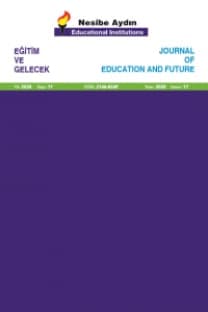Öğretmenlerle İlgili YouTube Videolarının Analizi
İnsanların öğretmenleri nasıl algıladıkları, onların birebir, yüz yüze etkileşimlerinin yanı sıra internetteki etkileşimleri ile de ilişkilidir. Literatürde öğretmenlerin verdikleri eğitimin bir parçası olarak YouTube'u kullanmaları incelenmiş olmasına rağmen, öğretmenlerin YouTube'ta nasıl temsil edildiklerine yönelik bir çalışma bulunmamaktadır. Bu çalışmanın amacı, öğretmenlerle ilgili YouTube videolarında öğretmenlerin nasıl sunulduğunu incelemektir. Rittberg, Dissanayake ve Katz'ın 2015 yılında yayımlanan çalışmasının (www.youtube.com) arama motoruna "öğretmen" kelimesi yazılarak elde edilen ilk üç sonuç sayfasındaki 60 video incelenmiştir. Arama sonucunda elde edilen videolarla ilgili şu bilgiler kaydedilmiştir: video adı, URL, arama sıralaması, videonun yüklenme tarihi, izlenim sayısı, beğenilme ve beğenilmeme sayısı. Videoların her biri "Bu videoda öğretmen ya da öğretmen kavramı nasıl sunulmuş? (olumsuz, tarafsız ya da olumlu) sorusu bağlamında iki bağımsız kodlayıcı tarafından kodlanmıştır. Sonuçlar incelenen videoların çoğunda öğretmenlerin olumsuz bir şekilde sunulduğunu açıkça ortaya koymuştur. Hatta, öğretmenleri olumsuz bir şekilde sunan videoların önemli bir kısmının öğretmenleri müstehcen sunduğu tespit edilmiştir. Elde edilen sonuçlar İnternet Bilgi Eşik Bekçileri teorisi (Laidlaw, 2010) ve Gerçekliğin Sosyal İnşası teorisi (Berger & Luckmann, 1991) ışığında tartışılmıştır. Çalışmanın sonuçlarına bağlı olarak şu tavsiyede bulunulmuştur: Yüksek eğitim kurumlarındaki öğretmen eğitimi programları gelecek nesil öğretmenleri yetiştirirken internette bolca rastlanan olumsuz öğretmen imajına yönelik hazırlıklı olmaya özen göstermelidirler. oluşturulmasında çok önemli bir yere sahip olan eleştirel düşünceye ağırlık vermelidir.
An Analysis of YouTube Videos about Teachers
The way people perceive teachers is closely linked to the way teachers are represented through interactions that take place in-person, as well as interactions that take place online. Even though teachers' use of YouTube videos as part of instruction has been examined in literature, there is no research regarding how teachers are represented on YouTube. The aim of this study is to evaluate YouTube videos concerning teachers in terms of how teachers are portrayed. By adapting a similar methodology to Rittberg, Dissanayake, and Katz (2015), the keyword "teacher" is searched on the YouTube search engine (www.youtube.com) and the first 60 videos (3 pages) were analyzed. The list of the videos and the basic information of each video (such as the video name, URL, search rank, date uploaded, total viewership, likes, and dislikes) was recorded. Each video's content, cover image, and title were independently coded by two reviewers as either negative, neutral, or positive in relation to the following question: "In what manner is the teacher (or the concept of teacher) portrayed in this video?" The results of this study clearly show that most of the videos examined portray the teacher in a negative manner. Furthermore, among the videos that portrayed the teachers negatively, a considerable amount represented teachers in a sexual manner. The results were discussed in light of the theory of Internet Information Gatekeepers (Laidlaw, 2010) and the theory of social construction of reality (Berger & Luckmann, 1991). Based on the findings of this study, following suggestion was made; Teacher education departments in the higher education institutions should pay close attention to prepare future teachers effectively so that the teachers are equipped with the knowledge to address adverse teacher image abundant on the Internet. Such programs should also emphasize the critical thinking, as it is pivotal in establishing media literacy.
___
- Berger, P. L. & Luckmann, T. (1991). The social construction of reality: A treatise in the sociology of knowledge. Harmondsworth: Penguin.
- Clifton, A., Mann, C., 2011. Can YouTube enhance student nurse learning? Nurse Education Today 31, 311-313.
- Cohen, J. (1960). A coefficient of agreement for nominal scales. Educational and Psychological Measurement, 20, 37-46.
- Laidlaw, E. B. (2010). A framework for identifying Internet information gatekeepers. International Review of Law, Computers & Technology, 24 (3), 263-276.
- May, O., Wedgeworth, M., & Bigham, A. (2013). Technology in Nursing Education: YouTube as a Teaching Strategy. Journal of Pediatric Nursing, 28 (4), 408-410. doi:10.1016/j.pedn.2013.04.004
- O'Connor, E. A. (2010). The effect on learning, communication, and assessment when student-created YouTubes of microteaching were used in an online teacher-education course. Journal of Educational Technology Systems, 39 (2), 135-154.
- Rittberg, R., Dissanayake, T., & Katz, S. J. (2015). A qualitative analysis of methotrexate self-injection education videos on YouTube. Clinical Rheumatology. DOI 10.1007/s10067-015-2910-5
- Snyder, S.L., Burke, S., 2008. Using YouTube in the classroom: a how-to guide. Available at http://www.itdl.org/Journal/Apr_08/article03.htm (Accessed 01/19/2016).
- Tamim, R. (2013). Teachers' Use of YouTube in the United Arab Emirates: An Exploratory Study. Computers in the Schools, 30 (4), 329-345.
- Yoder, P. & Symons, F. (2010). Observational measurement of behavior. New York: Springer Publishing Company.
- YouTube (2016). Statistics. Available at: https://www.youtube.com/yt/press/ statistics.html. Accessed July 13, 2014.
- ISSN: 2146-8249
- Yayın Aralığı: Yılda 2 Sayı
- Başlangıç: 2012
- Yayıncı: Nesibe Aydın Eğitim Kurumları
Sayıdaki Diğer Makaleler
Öğretmenlerle İlgili YouTube Videolarının Analizi
Türkçe - Teknoloji - Sanat - Sosyal Bilgiler (2t2s): Bütünleşik Öğrenme Uygulaması
Derya YILDIZ, Mustafa YAVUZ, Tuğba ÖZKARAL
Eralp BAHÇİVAN, Erhan GÜNEŞ, Mutlu TAHSİN ÜSTÜNDAĞ
Aday Öğretmenlerin Danışman Öğretmenlik Uygulamasına İlişkin Görüşleri (Muğla İli Örneği)
Saadet KURU ÇETİN, Funda NAYIR
Mevlüt ÖZBEN, Türkan KARAKUŞ, Engin KURŞUN, Yüksel GÖKTAŞ, Suat ÇELİK
Ortaöğretim Matematik Öğretmen Adaylarının Ders Planı Bilgilerindeki Değişimin Analizi
Gönül YAZGAN-SAĞ, Elçin EMRE-AKDOĞAN
Beethoven Op 110 Piyano Sonatı Birinci Bölüm Tema ve Geçiş Bölgelerindeki Modülasyonların Kurulumu
